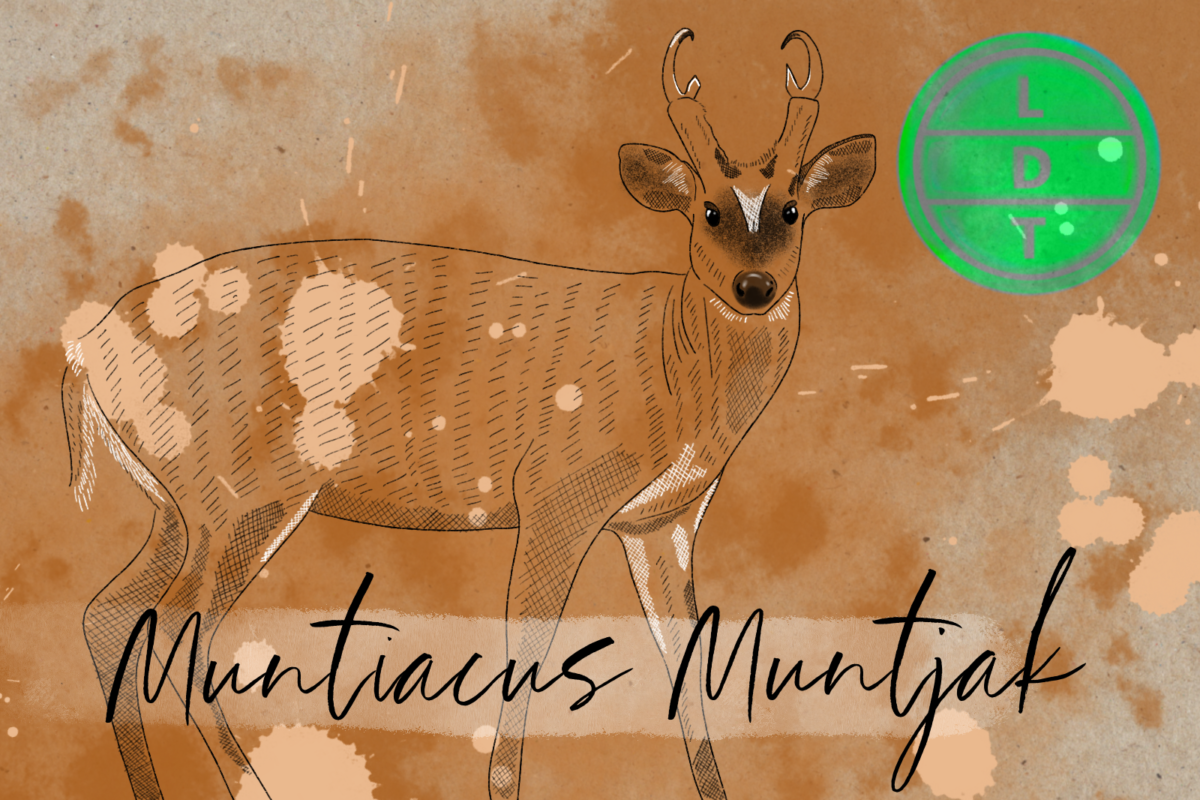“…and today we’re talking about a deer whose bark is worse than its bite. But more on that later.”
The forests of India are beautiful places to forage for nutritious greenery. Though the fantastic foliage looks tasty, it may be concealing a predator that’s equally appetized by you. If you’re a deer that’s detected a dastardly ne’er-do-well, what can you do to protect yourself? Such is the plight of the Indian Muntjac. But sometimes a borrowed tactic is the right one for the job in Life, Death, and Taxonomy.
Description of the Barking Deer
- The barking deer looks like a totally normal deer with absolutely no demonic wednego features whatsoever
- It actually has more of an antelope figure with short, red-brown hair; long, thin legs; and a short, white tail
- Their legs tend to be darker in males with whiter underbellies and necks. The coloration changes with the seasons
- There is actually quite a bit of sexual dimorphism
- Males have what I can only describe as a baboon deer face
- They have black fur on their nose and forehead
- Their skulls create sharp contours around their cheekbones and foreheads
- They also have these fleshy folds in between their eyes that look like rolled-up playdough cigars – these are large scent glands
- They also have a pair of antlers, the bottom half of which are covered in this layer of skin and fur called pedicels
- So they look like normal deer except for their face slugs and hairy horn tubes.
- Females have much more of a cute-deer aesthetic
Measure Up
Welcome to the beloved Measure Up segment. The official listener’s favorite part of the show! The part of the show when we present the animal’s size and dimension in relatable terms through a quiz that’s fun for the whole family. It’s also the part of the show that’s introduced by you when you send in audio of yourself saying, singing, or chittering the words Measure Up into ldtaxonomy at gmail dot com. We don’t have a new Measure Up intro this week!
Length
- 89–135 cm (35–53 in)
- How many barking deer could fit in the longest tunnel kiln in the world, lengthwise?
- Hint: A tunnel kiln is a factory furnace that’s used to heat materials that are passed through it continuously. The longest one ever is in India’s Carbonyx Technologies in Dahej.
- 163 muntjacs. The kiln is 720 feet (219.4 meters) long.
Weight
- 39 lbs (17 kilograms)
- How many muntjacs go into the record breaking Burmese python that was captured in Florida Everglades this summer?
- Hint: The python is the heaviest snake ever caught in Florida. It was found with an adult white-tailed deer in its digestive system. It also had a belly full of 122 eggs.
- 5.5 muntjacs. The python weighed 215 lbs, and it was 18 feet long.
Fast Facts about the Barking Deer
- Range: Southeast Asia including China, India, Bhutan, Burma, Thailand, Vietnam, Laos, Cambodia, Indonesia, Malaysia
- They live near water in dense forests
- Diet: they are omnivorous and eat grass, fruit, seeds, birds eggs, and even small animals (this is a deer that eats other mammals)
- Behavior:
- Barking deer are active day and night in the wild but in captivity they tend to be crepuscular (dawn and dusk)
- They have territories but they are not super territorial
- They form rangales of up to 5 deer
Major Fact: Barking from the Wrong Source
Barking deer are so called because their call sounds remarkably like a bark.
Deer are no strangers to vocalizations, but they are typically described as bleeding or bellowing like a typical herd animal.
Deer usually make sounds during the rut for the purpose of mating, but why does the barking deer bark?
Muntjacs were once thought to use their barks for two purposes: for the rut and as an alarm bell. But researchers now believe that these barks may only be used to signal that a predator is near.
When they detect a predator nearby, they start barking to let others know that something wicked this way comes. But why do prey animals do that?
The ensuing chaos can make it easier for individuals to escape, like Tom Cruise after crash landing in a vague foreign power’s mountain military base.
However, it is believed that barking deer also do it to tell ambush predators like tigers that they are no longer hidden and may as well give up.
When a muntjac starts barking, they may continue barking for more than an hour, totally ruining your stealth mission.
Barking may sometimes be a bluff. It’s more frequent in low visibility, which means they may start barking when they think a predator is close by, even if they don’t know exactly where it is.
Ending: So mark your territory, eat some bird eggs and small mammals, and bark warnings to your fellows like the muntjac here in LDT.

